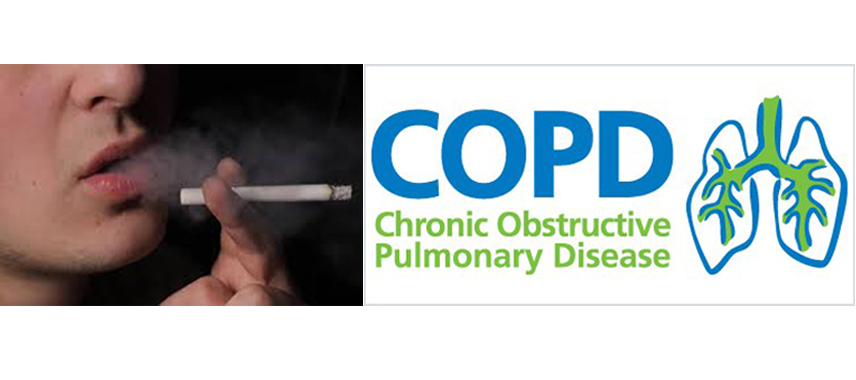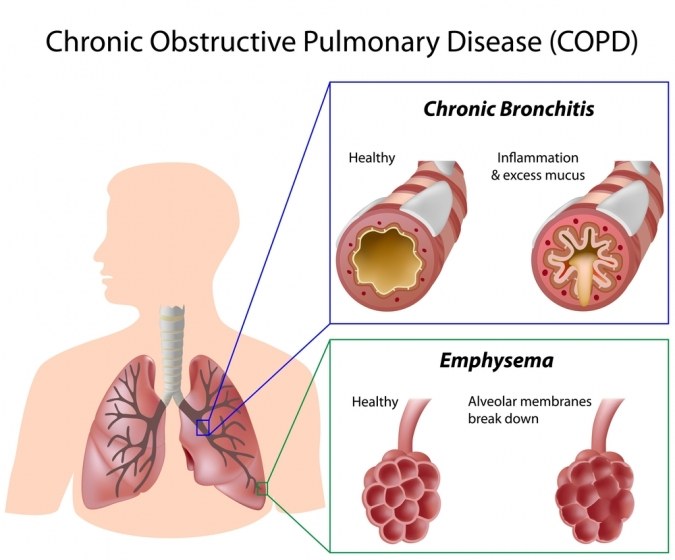
Chronic Obstructive Pulmonary Disease (COPD)
Introduction
Chronic Obstructive Pulmonary Disease (COPD) is an irreversible lung condition. Diseases classified as COPD cause swelling of the large airways in the lungs, which obstructs or blocks the flow of air. Symptoms of COPD include shortness of breath, coughing, wheezing, and decreased activity levels. Emphysema and chronic bronchitis are common forms of COPD. Cigarette smoking is the main cause of COPD.
COPD is a long-term condition that gets worse over time. Quitting smoking, lung rehabilitation therapy, and medications, including oxygen, may help to improve symptoms. Lung surgery or lung transplantation may be appropriate for select people with severe COPD.
Anatomy
Your lungs are located inside the ribcage in your chest. Your diaphragm is beneath your lungs. The diaphragm is a dome-shaped muscle that works to open your lungs when you breathe.
From your nose and mouth, air travels towards your lungs through a series of tubes. The trachea or windpipe is located in your throat. The bottom of the trachea separates into two large tubes called the main stem bronchi. The left main stem bronchus goes into the left lung, and the right main stem bronchus goes into the right lung.
Inside the lung, the bronchi branch off and become smaller. These smaller air tubes are called bronchioles. There are approximately 30,000 bronchioles in each lung. The end of each bronchiole has tiny air sacs called alveoli. There are about 600 million alveoli in your lungs. Each alveolus is covered in small blood vessels called capillaries. The capillaries move oxygen and carbon dioxide in and out of your blood.
When you breathe air in or inhale, your diaphragm flattens and your ribs move outward to allow your lungs to expand. The air that you inhale through your nose or mouth travels down the trachea. Tiny hair-like structures in the trachea, called cilia, filter the air to help keep mucus and dirt out of your lungs. The air travels through the bronchi and the bronchioles and into the alveoli. Oxygen in the air passes through the alveoli into the capillaries. The oxygen attaches to red blood cells and travels to the heart. The heart sends the oxygenated blood to the cells in your body.
When you breathe air out or exhale, the process is the opposite of when you inhale. Once your body has used the oxygen in the blood, the deoxygenated blood returns to the capillaries. The blood now contains carbon dioxide and waste products that must be removed from your body. The capillaries transfer the carbon dioxide and wastes from the blood into the alveoli. The air travels through the bronchioles, the bronchi, and the trachea. As you exhale, your diaphragm rises and your ribs move inward. As your lungs compress, the carbon dioxide is released out of your mouth or nose.

Causes
COPD is a lifelong condition that impairs the function of the lungs. Forms of COPD, such as emphysema and chronic bronchitis, cause swelling of the large airways in the lungs. Over time, this destroys certain lung structures and reduces the flow of air in and out of the lungs.
Cigarette smoking is the most common cause of COPD. In particular, cigarette smoking can damage the alveoli in the lungs and the cilia in the airways. As the condition progresses, the lungs do not exchange oxygen and carbon dioxide efficiently. Mucous that builds up can lead to an infection.
Symptoms
Symptoms of COPD include coughing, wheezing, shortness of breath, and decreased activity levels. You may or may not produce phlegm when you cough. As your condition progresses, breathing may become increasingly difficult. You may not have the energy to perform or tolerate activities like you used to. COPD can limit your lifestyle and quality of life.
As COPD worsens, you may experience episodes more frequently and develop serious complications. Your skin may have a bluish discoloration. You may have a pneumothorax, a condition where the lung collapses and air is on the outside of the lung. You may experience a significant weight loss. COPD can affect your heart. You may have an abnormal heartbeat. COPD can cause the heart to enlarge and lead to right sided heart failure.

Diagnosis
Your doctor can start to diagnose COPD by reviewing your medical history and conducting a physical examination. If you have already been diagnosed with COPD you should contact your doctor if your breathing becomes very difficult or if you experience other severe symptoms. You should tell your doctor about your risk factors, symptoms, and any changes in previous symptoms. Your doctor may order tests to detect infection, determine the extent of your condition, and decide on a treatment plan.
Your doctor will listen to the sound your lungs make while you breathe. You will be checked for rapid breathing or difficult breathing during simple activities. A sample of your phlegm will be checked for infection. A chest X-ray or high-resolution computerized tomography scan (HRCT scan) may be used to check for infection or structural changes in your lungs.
Your doctor may ask you to under go some tests called pulmonary function testing (PFTs). For example, your doctor will have you breathe into a hand-held device called a spirometer. A spirometer measures how much air you breathe out and how forcefully you breathe the air out. Your doctor will also have you breathe into a peak flow meter. A peak flow meter is a hand-held device that monitors the airflow through your bronchi. The peak flow meter measures your ability to expel air from your lungs under the best or peak conditions. Other more complex PFTs may be performed to further define your breathing condition. By monitoring the changes in your breathing patterns your doctor can identify how well your lungs are functioning, the severity of your symptoms, and appropriate treatment.
Your doctor may use a pulse oximeter to determine the amount of oxygen in your blood. For this test, a probe will simply be placed on your fingertip. A medical device attached to the probe displays the percentage of oxygen in your blood.
Treatment
The goals of treatment are to optimize your lung function, increase your activity tolerance, and improve your quality of life. The best thing you can do to improve your situation is to quit smoking. Talk to your doctor about methods to help you quit smoking if you are unable to do so yourself. Your doctor is happy to make recommendations and referrals to help you.
Your doctor can prescribe medications to help ease your symptoms and make it easier for you to breathe. Antibiotics may be used to fight infections. You may need to use a steady flow of oxygen.
It can be beneficial to participate in a lung rehabilitation or respiratory therapy program. Respiratory therapists can show you ways to optimize your breathing. Exercises can help to improve your endurance.
In severe cases, some people may need the help of a breathing tube or breathing devices. Some people with advanced COPD may be candidates for surgery. Lung reduction surgery is used to remove the damaged portion of a lung, allowing the remaining portion to perform better. Select people may be candidates for lung transplant surgery. Lung transplant surgery can improve activity levels and quality of life.
The experience of COPD can be an emotional process for people with the condition and their loved ones. It is important that you receive support from a positive source. Some people find comfort in their family, friends, co-workers, and faith. Lung disease support groups are another good option. They can be a good source of information and support from people who understand what you are experiencing. Ask your doctor for a lung disease support group locations in your area.
Prevention
Quitting smoking and avoiding second hand smoke can prevent COPD. You should follow your doctor’s treatment instructions, participate in your home respiratory therapy program, and call your doctor if your symptoms intensify to help prevent medical complications.
Am I at Risk
Risk factors may increase your likelihood of developing COPD, although some people that develop the condition do not have any risk factors. People with all of the risk factors may never develop the disease; however, the chance of developing COPD increases with the more risk factors you have. You should tell your doctor about your risk factors and discuss your concerns.
Risk factors for COPD:
Cigarette smoking or exposure to second hand smoke is the main cause of COPD.
Air pollution appears to contribute to COPD.
People with alpha-1 antitrypsin deficiency are at an increased risk for the COPD.Alpha-1 antitrypsin is a substance in the lungs that may protect against lung destruction leading to emphysema.
Complications
As COPD worsens, you may experience episodes more frequently and develop serious complications. Your skin may have a bluish discoloration. You may develop a pneumothorax, a condition where the lung collapses and air is on the outside of the lung. You may experience a significant weight loss.
COPD can affect your heart. You may have an abnormal heartbeat. COPD can cause the heart to enlarge over time and lead to right sided heart failure. You should call the emergency medical services in your area, usually 911, or have someone drive you to a hospital emergency department if you are having a significant problem breathing or are experiencing a heart attack.
References:
• www.copdfoundation.org
• HealthWise: COPD (Chronic Obstructive Pulmonary Disease)







